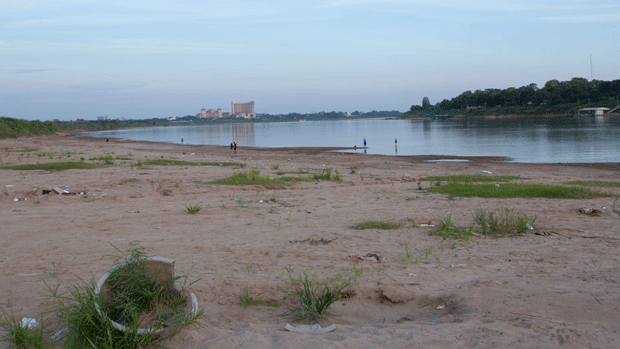China’s Jinghong Dam Runs ‘Tests’ Dropping Water Levels in Downstream Laos
Source: RFA
Equipment testing at China’s Jinghong Dam in the first week of January will reduce water it releases into the Mekong River by more than 50 percent, dropping water levels even further in a region already hit by a severe drought, sources say.
The move, announced by China’s Ministry of Water Resources on Dec. 30, has already affected villagers in the Golden Triangle region of Laos, residents of the area told RFA’s Lao Service on Jan. 3, with one villager saying the level of the river has visibly dropped.
“Yes, the water level has dropped,” the resident of Sibounhuang Village in Bokeo province’s Ton Pheaung district told RFA, speaking on condition of anonymity. He compared the degree of drop to the dry season, which Lao entered in late 2019.
“We rely on water from the Mekong, so if this trend continues, we won’t have enough water for our own consumption,” he said.
Many of the Lao district’s other villages are feeling the impact of the fall in the Mekong’s water level, residents told RFA, with one resident of Golden Triangle Village saying that navigation in the area by large boats has now been made impossible “because of shallow water.”
“Even for small boats, it’s not easy,” he said.
Also speaking to RFA, a fisherman in Thailand’s Chiang Rai province, along which the Mekong flows, said, “They told us they will be holding water back for testing equipment or something, and the water will drop.”
“The Mekong bank is an agricultural area, where villagers grow their vegetables, so their crops will definitely be affected by the lack of water,” he said.

The intergovernmental Mekong River Commission (MRC) issued a notice that the Jinghong dam will be reducing the volume of water released from 1,400 cubic meters to 800 cubic meters per second, resulting in a fall in Mekong River water levels in Laos of as much as 70 centimeters through Jan. 10.
‘Problem for a long time’
Speaking to RFA on Jan. 2, Niwat Roykaew—president of Thailand’s Rak Chiang Khong conservation group—said that the opening and closing of Chinese dams on the Mekong has been a problem for neighboring countries for a long time.
“By now, the Chinese government should have realized that this has severely impacted people living downstream. What we have been demanding all along is that we try to solve these problems together,” he said.
Meanwhile, loss of sediment blocked by dams and falling water levels due to a drought described by the MRC as the region’s worst “over the last 60 years” have turned long stretches of the Mekong blue, as river water now begins to reflect the sky overhead.
Laos itself has also built dozens of hydropower dams on the Mekong and its tributaries in its quest to become “the battery of Southeast Asia,” exporting the electricity they generate to other countries in the region, and is preparing to build scores more dams in the years ahead.
Though the Lao government sees power generation as a way to boost the landlocked country’s economy, the projects are controversial because of their environmental impact, displacement of villagers, devastation of fisheries, and questionable financial arrangements.
Reported by RFA’s Lao Service. Translated by Max Avary. Written in English by Richard Finney.

